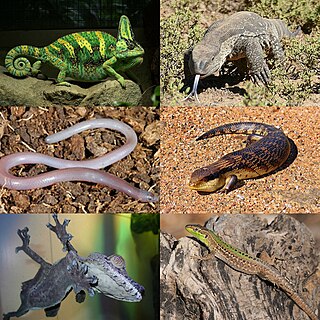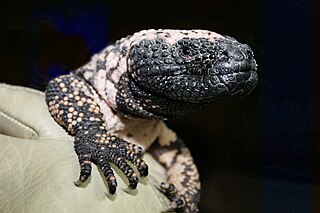Related Research Articles

Lizard is the common name used for all squamate reptiles other than snakes, encompassing over 7,000 species, ranging across all continents except Antarctica, as well as most oceanic island chains. The grouping is paraphyletic as some lizards are more closely related to snakes than they are to other lizards. Lizards range in size from chameleons and geckos a few centimeters long to the 3-meter-long Komodo dragon.

Squamata is the largest order of reptiles, comprising lizards and snakes. With over 12162 Species, it is also the second-largest order of extant (living) vertebrates, after the perciform fish. Squamates are distinguished by their skins, which bear horny scales or shields, and must periodically engage in molting. They also possess movable quadrate bones, making possible movement of the upper jaw relative to the neurocranium. This is particularly visible in snakes, which are able to open their mouths very wide to accommodate comparatively large prey. Squamates are the most variably sized living reptiles, ranging from the 16 mm (0.63 in) dwarf gecko to the 6.5 m (21 ft) reticulated python. The now-extinct mosasaurs reached lengths over 14 m (46 ft).

Heloderma is a genus of toxicoferan lizards that contains five species, all of which are venomous. It is the only extant genus of the family Helodermatidae.

Marine reptiles are reptiles which have become secondarily adapted for an aquatic or semiaquatic life in a marine environment. Only about 100 of the 12,000 extant reptile species and subspecies are classed as marine reptiles, including marine iguanas, sea snakes, sea turtles, and saltwater crocodiles.

A goanna is any one of several species of lizard of the genus Varanus found in Australia and Southeast Asia.

The desert iguana is an iguana species found in the Sonoran and Mojave Deserts of the Southwestern United States and northwestern Mexico, as well as on several Gulf of California islands.

The blue iguana, also known as the Grand Cayman ground iguana, Grand Cayman blue iguana or Cayman Island rock iguana, is an endangered species of lizard which is endemic to the island of Grand Cayman. It was previously considered to be a subspecies of the Cuban iguana, Cyclura nubila, but in a 2004 article Frederic J. Burton reclassified it as a separate species because according to him the genetic differences discovered four years earlier between the different C. nubila populations warranted this interpretation. The blue iguana is one of the longest-living species of lizard.
Robert Friedrich Wilhelm Mertens was a German herpetologist. Several taxa of reptiles are named after him. He postulated Mertensian mimicry.

Toxicofera is a proposed clade of scaled reptiles (squamates) that includes the Serpentes (snakes), Anguimorpha and Iguania. Toxicofera contains about 4,600 species, of extant Squamata. It encompasses all venomous reptile species, as well as numerous related non-venomous species. There is little morphological evidence to support this grouping; however, it has been recovered by all molecular analyses as of 2012.

Iguania is an infraorder of squamate reptiles that includes iguanas, chameleons, agamids, and New World lizards like anoles and phrynosomatids. Using morphological features as a guide to evolutionary relationships, the Iguania are believed to form the sister group to the remainder of the Squamata, which comprise nearly 11,000 named species, roughly 2000 of which are iguanians. However, molecular information has placed Iguania well within the Squamata as sister taxa to the Anguimorpha and closely related to snakes. The order has been under debate and revisions after being classified by Charles Lewis Camp in 1923 due to difficulties finding adequate synapomorphic morphological characteristics. Most iguanians are arboreal but there are several terrestrial groups. They usually have primitive fleshy, non-prehensile tongues, although the tongue is highly modified in chameleons. Today they are scattered occurring in Madagascar, the Fiji and Friendly Islands and Western Hemisphere.

Mark Timothy O'Shea is an English herpetologist, photographer, author, lecturer, and television personality. He is known internationally as the presenter of the Animal Planet/Discovery Channel series O'Shea's Big Adventure.

The Jamaican iguana, also known commonly as Colley's iguana, is a large species of lizard in the family Iguanidae. The species is endemic to Jamaica. It is critically endangered, even considered extinct between 1948 and 1990. Once found throughout Jamaica and on the offshore islets Great Goat Island and Little Goat Island, it is now confined to the forests of the Hellshire Hills.

The Australian Reptile Park is located at Somersby on the Central Coast of New South Wales, Australia. It is about 71 kilometres (44 mi) north of Sydney, and is just off the M1 Pacific Motorway, near Gosford. The Park has one of the largest reptile collections in Australia, with close to 50 species on display. The wide variety of reptile species at the Park includes snakes, lizards, turtles, tortoises, tuataras, American alligators and crocodiles.

The green iguana is the most globally traded reptile representing 46% of the total reptile trade in the US from 1996 and 2012, with annual imports reaching 1 million in 1996. In 1995, there were over 800,000 animals were imported into the United States alone, primarily originating from captive farming operations based in their native countries .The green iguana has also seen a surge of importation in the Greater Caribbean Region. A study done on invasive iguanas in Puerto Rico found that the sample population were mostly the product of populations originating from Columbia and El Salvador. Both countries contain several industrial-size pet iguana farming operations.

Iguana is a genus of herbivorous lizards that are native to tropical areas of Mexico, Central America, South America, and the Caribbean. The genus was first described in 1768 by Austrian naturalist Josephus Nicolaus Laurenti in his book Specimen Medicum, Exhibens Synopsin Reptilium Emendatam cum Experimentis circa Venena. Two species are placed in the genus: the green iguana, which is widespread throughout its range and a popular pet and the Lesser Antillean iguana, which is native to the Lesser Antilles. Genetic analysis indicates that the green iguana may comprise a complex of multiple species, some of which have been recently described, but the Reptile Database considers all of these as subspecies of the green iguana.
The East Bay Vivarium is a shop located in Berkeley, California, in the United States. The store is more than forty years old, the oldest and largest store of its kind in the United States. It sells snakes, lizards, various other reptiles and amphibians, as well as the supplies to maintain and care for them. The store is open to reptile enthusiasts, hobbyists, and the general public. The store has been deemed a "must-see" by Disney family and the "strangest attraction" in Berkeley by The New York Times.
Tom Crutchfield, also known as Tommy, is an American reptile breeder known for his extensive Homestead, Florida, facility and his 1999 arrest and conviction under Operation Chameleon for trafficking in exotic animals and violating the Lacey Act, which temporarily suspended his business. He has called himself "the Mick Jagger of the reptile business". The case was later featured on National Geographic's Locked Up Abroad. He is also the focus of the 2008 book by Bryan Christy, The Lizard King, along with Michael Van Nostrand of Strictly Reptiles, and the 2011 book Stolen World by Jennie Smith.

The green iguana, also known as the American iguana or the common green iguana, is a large, arboreal, mostly herbivorous species of lizard of the genus Iguana. Usually, this animal is simply called the iguana. The green iguana ranges over a large geographic area; it is native from southern Brazil and Paraguay as far north as Mexico.

Robert Cyril Stebbins was an American herpetologist and illustrator known for his field guides and popular books as well as his studies of reptiles and amphibians. His Field Guide to Western Reptiles and Amphibians, first published in 1966, is still considered the definitive reference of its kind, owing to both the quality of the illustrations and the comprehensiveness of the text. A professor of zoology at the University of California, Berkeley, for over 30 years, he was the first curator of herpetology at the Museum of Vertebrate Zoology, a 1949 Guggenheim fellow, and author of over 70 scientific articles. His discovery of the ring species phenomenon in Ensatina salamanders is now a textbook example of speciation, and he performed extensive research on the parietal eye of reptiles. He produced nature films, supported science education in primary grades, and organized conservation efforts that aided in the passing of the 1994 California Desert Protection Act. After retirement he continued to paint, collect field notes, and write books. Stebbins is commemorated in the scientific names of three species: Batrachoseps stebbinsi, the Tehachapi slender salamander; Anniella stebbinsi, a legless lizard; and Ambystoma tigrinum stebbinsi, the endangered Sonora tiger salamander.

Human uses of reptiles have for centuries included both symbolic and practical interactions.
References
- ↑ "Larchmont Chronicle Story Archive". 2006-10-22. Archived from the original on 2006-10-22. Retrieved 2024-06-10.
- "Reptiles: Snakes and Lizards", Nature, 2002. (PBS)
- Van Houten, Carolynne. "Become a True Believer - Ripley's talk to cover the wildly unusual museum creator" , Ocean County Observer. August 20, 2006.
- Filipek, Suzan. "Henry Lizardlover" , Larchmont Chronicle. September 2, 2003.
- "Iguana images by Henry Lizardlover" , Today's Planet.
- Lizardlover, Henry; Rosenthal, Karen L. The Iguana - An Owner's Guide to a Happy Healthy Pet, Howell Books. July 1, 1996.